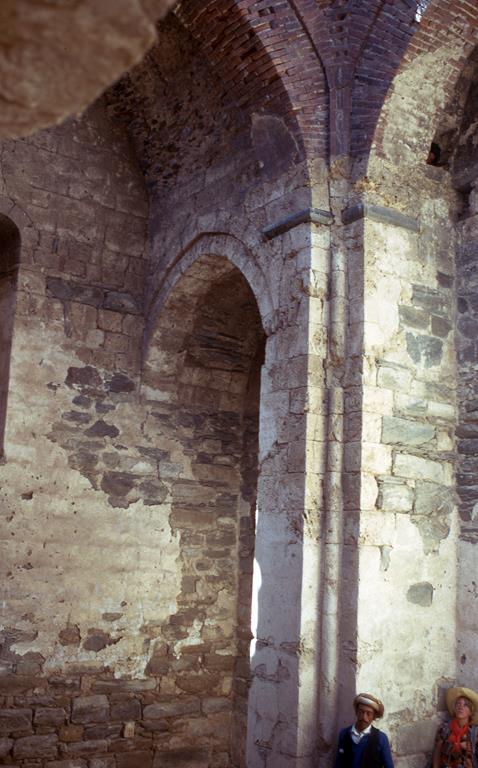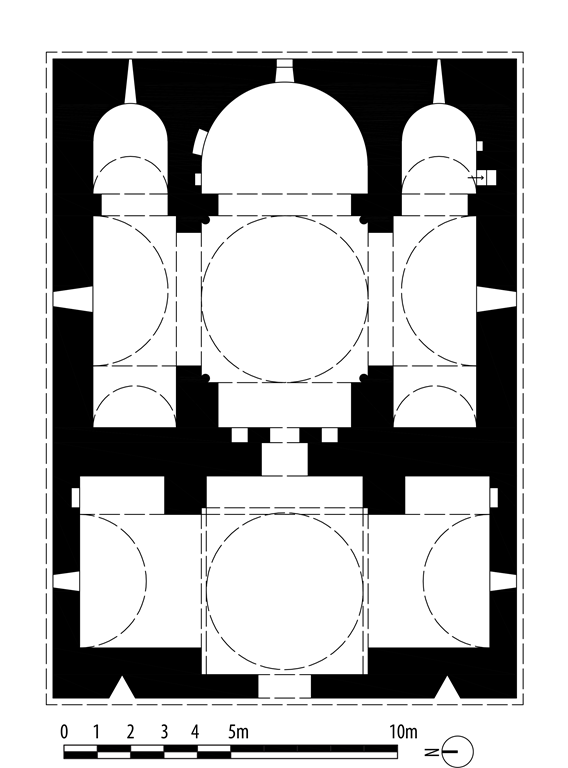The Holy Cross monastery of Khizan [Hizan] is located southwest of new Khizan [Yeni Hizan, Karasu] in the Armenian canton of Ishayr, at 38° 11’ N and 42° 31’ E. It stands in the hills above the village of Surp Khach (“Holy Cross”) [Simhaç], high above the mouth of the Shinitzor or Shinatzor [***] Valley by which name it is also known.

Angle ouest, 1973 (Fonds N. et M. Thierry).
The unusual architecture of the monastery church, whose plan has no equivalent in the Armenian domain, suggests Byzantine influence and a probable construction date around the year 1000. The monastery was already a productive scriptorium in the 14th century, and, together with the monasteries of the Holy Mother of God of Paritzor (n° 24) and Saint Gamaliel, comprised one of the centers of the Khizan school of copyists and illuminators, which was to remain active until the mid 17th century. A disciple of abbots John (Hovhannes) and Cryiacus (Guragos), the copyist John, nicknamed the Orator, already excelled there in 1382 and then under Abbot Baptist (Mgrditch) until 1413; in his wake appeared Bishop Stephen (Sdepannos), who joined the Holy Cross in 1414 but whom we find at the head of Saint Gamaliel in 1431. Among many other copyists and illuminators more generally representative of this school, we must mention the miniaturist John of Khizan (Hovhannes Khizantsi, attested from 1390 to 1417) and Mardiros of Khizan (Mardiros Khizantsi), who in 1604 completed a synaxarion, or book of saints, commissioned by Khoja Khachig, mayor of far-off Julfa and father of a line of mayors who would head the faubourg of New Julfa in Isfahan, which in the 17th century and until the 1720s was the major center of Armenian trade. If the prior Isaac (Sahag) is mentioned in 1750 as a Doctor of the Church and theologian, his homonym in the 1870s-1880s devoted himself mainly to protecting the monastery and its possessions from incursions and looting by the beys, whose men a few decades earlier had assassinated the catholicos of Aght‘amar, Harut‘iun I of Ardonk‘ (Harut‘iun Ardonetsi 1816-1823) within the monastery walls. To be sure, Isaac undertook the restoration of the buildings, but the monastery was invaded and all its possessions appropriated in the massacres of 1895.
The Holy Cross monastery of Khizan or Shinitzor included:

Plan (Thierry, 1989, 382)
• The tri-apsidial church of the Holy Cross, dating from the turn of the 11th century, built on a cross-in-square plan measuring 12.5 × 14.3 m, with a brick dome and dihedral pillars – two of which are engaged in the west wall –, side chambers above the absidioles and chambers open to the west in the north and south arms of the cross;
• A narthex with a central dome and brick patterns extending the church 6,4 m to the west;
• Monastery buildings and a fountain.
The monastery was confiscated after the Great War. The dome and the northeast corner of the church collapsed in 1950. Nevertheless the church was still standing in 1973, as was its narthex. In 2012 however only a few sections of the walls and nothing of the other constructions remained. Stones still marked with crosses can be found in private homes.
Épriguian, 1903-1905, II, 170-174. Akinian, 1920, 168. Oskian, 1940-1947, III [1947], 855-862. Kurdian, 1951, 21-22, 66-68. Thierry, 1989, 380-384. Devgants, 1991, 173, 229.